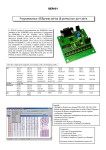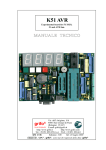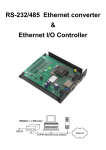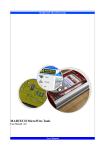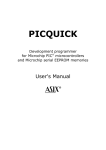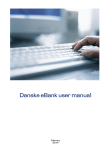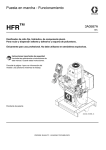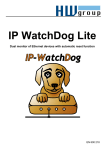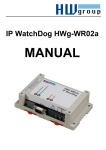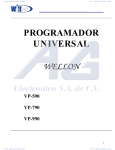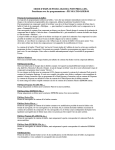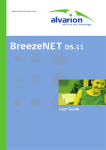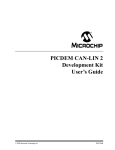Download ORDER FORM - Web51 - HW
Transcript
Order form Order No. 900221 900225 900224 900176 900188 900189 900208 900222 900168 900201 900234 900235 900182 900216 900213 ## # HW Server Product RTL 8019 CHIP SET Web51 HW KIT Web51 SW & licence only Web51 Design KIT Web51 Design KIT + D. Supp. Web51 Designer support RS 232 ETHERNET converter ETHERNET I/O Controller PonyProg – programmer kit PAtmel – programmer kit Charon - Web51 ver. 6.x module Charon Motherboard MU Alpha M631/E AWG M621/E DSO Address: Rumunska 26, Prague 2,120 00 Czech Republic EUROPE Qty Total Subtotal: Shipping *): Total USD: DATE Phone : +420 222 511 918 email: [email protected] USD $35 $170 $220 $280 $315 $60 $250 $280 $60 $60 $80 $35 $298 $798 $798 All the prices are in the USD. Prices are subject to change without notice. *) Shipping depends on the destination country and total weight. Let us know where are you from and which products are you going to order. We will promptly notify you of the shipping charge. Approximate shipping: Europe - $40, USA - $45, Asia - $50, Other countries - $55 (0,5 kg package) Please fax this form to: +420 222 513 833 Payment Method (please tick) Prepaid (check enclosed, add please 20 USD-servicecharge) Personal check (we ship after the check has cleared-takes 4-6 wks) Wire tranfer instructions : Jan Rehak, eBanka, a.s. - 1424 6028 / 2400 Na Prikope 19, Praha 1-CZECH REPUBLIC ZIP: 117 19, SWIFT CODE: CEKOCZPP Wire transfer (ask for instructions please) Please confirm your payement by email Credit Card: VISA Eurocard/MasterCard Deliver to: Card number Security ID We will ship to this address last three digits on the signature panel on the Company back of the card, printed after the card number Exp. Date: Month Year Name Title Name on card: Number of another ID document for closer identification Driver’s license Passport Phone - required Social security No. Fax Number: E-mail - required Billing address: City / State / Zip: Street address / PO BOX Charge the following amount to my account : Authorized signature : Order form USD City State ZIP www.HW-Server.com +:VHUYHU www.HW-server.com HW pricelist HW server – Who are we We are a production and development company. We also operate a local Internet portal concentrating on development and production of electronics, microcontroller technology and automatization. Our Czech WWW pages are visited by about 1,800 unique IP's daily and about 25,000 unique readers monthly, in a country populated by just 10 million people. Our main products include Ethernet applications and development tools for electronics. We also represent several foreign companies in the Czech Republic and Slovakia regions. Summary of our products: RTL 8019 CHIP SET Realtek RTL8019 and transformer 20F001N + unique MAC address from the Web51 address space Web51 HW KIT Simplified hardware with the features of small Web server Web51 SW & licence only Software of the Web51 system under a commercial license Web51 Design KIT HW and SW development KIT based on Web51 technology Web51 Design KIT + D. Supp. HW and SW development KIT based on Web51 technology. Designer support is a service that ensures updates for 18 months for no extra cost, training and literature discounts, and other advantages. Web51 Designer support Designer support ensures updates for 18 months for no extra cost, training and literature discounts.. RS 232 ETHERNET converter Ethernet to RS232/RS485 converter based on Web51 project ETHERNET I/O Controller Allows remote control and monitoring of up to 24 inputs and outputs, temperature measurement, and much more PonyProg – programmer kit Simple programmer kit for Atmel, Microchip MCUs, Serial EEPROMs, Flashs PAtmel – programmer kit Atmel programmer kit MU Alpha Full hardware emulator of PIC16F84[A], 12C508A[509A], 16C54C..56A up to 20MHz MU Beta Hardware emulator of PIC12C508 – 16F628 up to 20MHz PICQUICK Programmer for all PICs and Serial EEPROMs with device upgrades available on Internet M631/E AWG The Arbitrary Waveform Generator M621/E DSO 150 MHz Digital Storage Oscilloscope www.HW.cz / www.HW-server.com - HW server +:VHUYHU www.HW-server.com Web51 - Ethernet in x51 MCU – free sources Web51 is originally an open-source project that connected Ethernet to an 8052 microcontroller. This international project has started from a network board connected to a microcontroller. Development versions can be found in China, Korea, Australia or in the South Africa. Web51 development system can be used under almost any OS. Most utilities needed for compiling and other tasks are available in most operating systems. The development system directly supports DOS32 (MS-DOS with 32-bit support, Windows) and Linux (x86 platform). The Web51 project is written entirely in assembly. There is not enough RAM space for a higher-level language in the basic version. If the RAM is extended and the full version libraries are used, a C compiler such as SDCC can of course be used. • • The project is interesting for its open source code, extensive libraries, number of supported peripherals etc.. The x51 microcontrollers don't offer much processing power and are rather expensive; however, they are very common so are the development tools and the general knowledge about them. • • • Hardware fully documented include all datasheets, development boards.. • • Web51 is currently available in ASM version (SDCC version will be released in October 2002). Due to design complexity and limited MCU power, Web51 is not intended for complicated applications. It is ideal for instance for telemetry systems where a single chip is used (the x51 MCU) and the Ethernet interface needs to be added. The whole project has licensed an unique range of MAC addresses from IEEE. Besides the development series, we also offer turn-key applications based on Web51 with open HW designs. Licensing strategy We, the authors of the Web51 system, offer the following two versions: • Free version – Covered by GNU GPL, available for download free of charge from http://web51.hwserver.com including source codes. However, some subroutines (such as RTL8019 control) are inside a library that is distributed in binary form only. Available are several versions of the library, differing by the configured number of simultaneous TCP connections supported. • Commercial version – Includes all source codes of the project. It is not limited by GNU GPL. It is distributed together with our development system (our own assembler and linker). Available for purchase with the HW kit or separately. Please e-mail us for details. Web51 GNU project The entire solution of a small WWW server at port 80 and a TELNET server at port 23 is an open project available under the GNU General Public License. Its source code can be downloaded free of charge from our project page. Available is the source code for the project except the communication library, which is available in binary form only. A package of free GNU software also contains development tools including assembler and linker. www.HW.cz / www.HW-server.com - HW server +:VHUYHU www.HW-server.com RTL 8019 CHIP SET The Web51 project is open in terms of SW as well as HW. If you want to create your own project with a similar hardware, you may find it difficult to purchase the RTL8019AS Ethernet controller in small quantities. Therefore, we offer a separate set of components that can bring Ethernet to your microcontroller. • • • Transformer 20F001N RTL8019AS Unique MAC address from the Web51 Project address space 3ULFH Web51 HW KIT Simplified hardware designed for initial familiarization with the features of a small Web server. Complete documentation is available on the project web pages. In this simplified kit, the Ethernet controller RTL8019AS is connected to 16 pins of a x51 compatible controller in DIL package. A fully functional WWW server that responds to Echo requests and serves HTML pages with simple scripting support manages with only 256 B of internal memory and 8 kB of FLASH in the micro. All published examples work with this hardware and can be loaded and run right away (such as I/O control, simple temperature measurement, LCD interface, TELNET access to serial port over a TCP/IP network, and more). 3ULFH Design KIT HW and SW development KIT based on Web51 technology. Contains Web51 KIT with AT89S8252 and T89C51RD2 controllers and a CD ROM containing everything from our Ethernet CD as well as library source code. The library is subject to the commercial license and can be redistributed in binary form only. The KIT also includes our development environment for Windows and Linux, unique MAC address and a printed manual. The Design KIT further includes a pre-paid royalty and a commercial license for the use of the Web51 system. Designer support Designer support is a service that ensures updates for 18 months for no extra cost, training and literature discounts, and other advantages. If requested, we can also grant you another batch of MAC addresses and waived royalties with purchase. :HE'HVLJQHU.,73ULFH :HE'HVLJQHU.,7'6XSS3ULFH www.HW.cz / www.HW-server.com - HW server +:VHUYHU www.HW-server.com LPT ISP KIT Certain microcontrollers by ATMEL, such as the AVR family, ATmega, and several x51 compatibles (AT89LS8252) can be serially in-system programmed with this kit. Features • • • • • Connected to LPT Port PonyProg Software for Windows 95,98 i Windows NT/2000 Bus driver ensures fast SCK edges, avoiding problems described in ATMEL Errata docs Software is friendly to the user and developer Indication of programming progress and power status 3ULFH Web51 - SW & License Software of the Web51 system under a commercial license. • • • • CD with complete docs, source codes, PDF and HTML manuals Commercial license that does not contain GPL limitations Assembler, linker, programming utilities, development environment Firmware supports sending e-mails (starting from version 1.14) To speed up the delivery, you can request to have the basic sources delivered by e-mail. This way, you don't have to wait for the CD and printed license. 3ULFH RS 232/485 ETHERNET converter Converts a serial line to a TCP/IP or UDP/IP connection running on top of Ethernet. Allows communication between two devices or between a device and a computer (server or workstation). It can be used as a buffer for data from a serial port, for remote control of a manufacturing process, or to connect a peripheral remotely. Application support includes subroutines for device control in various programming languages and operating systems. The converter can be built into a custom peripheral. Hardware is fully documented. Features • • • • • • • • • • • Makes a RS232 serial port accessible over an Ethernet network Interfaces: RJ45 - 10BaseT, RS232 Converter parameters configurable locally over RS232 Simple usage and set-up Supports TCP/IP for data transfer (Telnet-like client) Optional UDP transfer activation with RS485 support RS485 protocol properties configurable, reducing response time to about 10ms per 10-char packet Start and end delimiters of a transferred block of data Support for passive and active mode (converter can establish connection upon activity on the serial port) Two converters can effectively extend a serial port over the Ethernet Security accomplished by specifying IP address and netmask for communication with the other side; support for 128-bit TEA-encrypted authorization in TCP/IP communication 3ULFH www.HW.cz / www.HW-server.com - HW server +:VHUYHU www.HW-server.com ETHERNET I/O Controller Allows remote control and monitoring of up to 24 inputs and outputs, temperature measurement, and much more. Control and monitoring is accomplished by an authorized WWW interface, Telnet with support for establishing connection upon changes, or by e-mail. Typical applications include an intelligent watchdog controlled over the network that can buffer and send out reports about performed operations or changes on inputs. A library adding support to certain visualization and control software packages is available. For example, the device can Ethernet-enable a security panel or a PBX, turn appliances on or off, or send you an e-mail saying "A mouse is in the mousetrap, remove it and add cheese" -without a need for any PC. • • • Controlled over WWW pages and TELNET Able to send e-mail upon defined events Support for "watchdog"-type applications 3ULFH www.HW.cz / www.HW-server.com - HW server +:VHUYHU www.HW-server.com IrAMP – Remote IR PC Controll This interface allows to control a PC remotely using an infrared remote control. Supported by more than ten programs from all over the world due to compatibility with the existing UIR standard. In a small box (3 x 1.5 x 4 cm), IrAMP has its own microcontroller that recognizes encoding used by standard remotes and converts the received sequence to 6 bytes that are then sent to the PC over RS232. Each 6-byte sequence uniquely identifies its key on the remote. The control software allows you to turn off your PC, run applications such as WINAMP and control them remotely, etc. For example, you can set the program to run WINAMP with a classics playlist whenever a certain button is pressed on the remote, to switch to modern music playlist with another button, control MUTE, fast forward, and close WINAMP. If WINAMP is not active, the same buttons can be used to control your PowerPoint presentation, TV card or sound card, insert characters, etc... Product specification • • • • • • • • No supply adapter necessary Connects to RS232 Communicates at 9600Bd, 8N1 Fully compatible with RC5 Adaptive algorithm for other standards Not compatible with IrDA. WINAMP plugin is available The GIRDER program allows remote control of the entire PC 3ULFH PAtmel3 - KIT Cheap programmer for AT89C5x, AT89Sxxxx, AT90Sxxx, AT89Cx051, AT24Cxx with ISP support. The PAtmel programmer version 3 supports most 51 and AVR series microcontrollers by Atmel. The hardware supports all operations with the devices, that is reading, writing, erasing and verification of the program and data memories and setting of lock and fuse bits. The component side of the board contains just 3 precision sockets for the programmed devices in DIP8, DIP20 and DIP40 packages. Most devices can be auto-detected by their signature bytes. The programmer also contains an ISP connector for programming AVR's and certain x51 compatibles by Atmel in the target system. Features • Software: - Windows95, 98 - Windows 2000, NT - Windows XP • Actually supports: - I2C Bus EEPROM - x51 (AT89C5x, AT89Sxxxx) - AVR - MCUs with ISP support • Dimensions: 86 x 60 / height 15 [mm] This speeds up debugging and development of applications. The programmed device can be reset by clicking a button in the software toolbar. The core of the programmer is an AT89C51 microcontroller that performs all operations with the device being programmed. The target device is inserted into one of the precision sockets. Power is supplied by an external 12V/300mA supply with a coaxial connector, positive pole is inside. Power is indicated by the green LED, operation in progress is indicated by the red LED. The programmer connects to the computer via the serial port. All timing is controlled by the microcontroller inside the programmer. This solution ensures the best support possible in all operating systems. We can supply a complete KIT (populated and tested PCB) or just the PCB and the microcontroller. www.HW.cz / www.HW-server.com 3ULFH - HW server +:VHUYHU www.HW-server.com PonyProg KIT PonyProg is a powerful programmer kit that supports a wide range of devices, is controlled by simple software, and is available for a friendly price. The low price comes at the cost of direct access to PC port hardware. External circuitry is minimal, causing some problems in certain operating systems. The main board contains sockets for most common devices. The PonyProg software can control other devices (e.g. Siemens EEPROM-SDE2516, SDE2526, and more), connected through external adapters, with the same user interface. The PonyProg software is mature, supports Windows NT. Contains a nice buffer editor, fill functions, serial number generator, and supports even the standard hardware interface of the STK 200/300 and other kits. The hardware looks simple at a first glance; however, it is a result of complex tradeoffs. It is adjusted to various interpretations of the RS232 standard by PC manufacturers; for example, some notebooks output only 5V on their RS232 ports. Therefore, PonyProg implements a special low-drop 5V stabilizer that operates at 50mA with just 0.2V drop. The programmer therefore works well in "off-site" conditions; the RS232 serial port usually provides enough power to program FLASH devices. For simpler operation and lower cost, we have used a single-board solution with individual sections being switched using a ribbon cable with PFL connectors. Features • Connects to RS232. • Powered by RS232 currents or external AC/DC adapter 5-30V (more then 14V is necessary for pragramming OTP PIC MCUs). • User friendly software with grafical interfaces and support for scripts • Drivers: - Windows95, 98 - Windows 2000, NT - Intel Linux - Win XP drivers is not available yet • Actually supports: - I2C Bus EEPROM - Microwire EEPROM - SPI EEPROM - Atmel AVR & 51 (s ISP) - Microchip PIC micro Complete shipment contains a tested Hardware KIT, CD with software and datasheets, and a printed manual. Supports • • • • • • • • • • • • • • • • • • 24C01, 24C02, 24C04, 24C08, 24C16, 24C32, 24C64, 24C65, 24C128, 24C256, 24C512 I2C Bus EEPROM 24C325 and 24C645 I2C Bus EEPROM Siemens SDE2516, SDE2526, SDA2546, SDA2586, SDA3546, SDA3586 EEPROM (as 24XX Auto) • Dimensions: AT17C65, AT17C128, AT17C256, AT17C512, AT17C010 I2C Bus 140 x 74 / height 18 [mm] EEPROM Siemens SDE2506 EEPROM AT90S1200, AT90S2313, AT90S2323, AT90S2343, AT90S4414, AT90S4434, AT90S8515, AT90S8535 Flash micro AT90S2323, AT90S2343, AT90S2333, AT90S4433, AT90S4434, AT90S8535, AT90S8534 AVR microcontroller ATmega103, ATmega161, ATmega163, ATmega 323, ATmega128, ATmega8, ATmega16, AVR ATtiny microcontroller ATtiny12, ATtiny15 - read ATtiny12 and ATtiny15 Oscillator Calibration Byte, Write lock bits to protect the AVR micro from reading the AT89S8252 and AT89S53 micro 93C06, 93C46, 93C56, 93C57, 93C66, 93C76, 93C86, 93C13, 93C14 PIC 16F873/874/876/877, PIC 16F84A, PIC 12C508/509 micro PIC 12C671/672 micro (untested) 25010, 25020, 25040 SPI EEPROM 25080, 25160, 25320, 25640, 25128, 25256, 25642 and 95640 Big SPI EEPROM NVM3060 eeprom MDA2061/MDA2062 eeprom X2444/X2445 eeprom 3ULFH www.HW.cz / www.HW-server.com - HW server +:VHUYHU www.HW-server.com PICQUICK PICQUICK is very fast, reliable and cost effective development programmer for all Microchip PIC microcontrollers and Microchip serial E2PROMs. One of many great advantages of PICQUICK is its support for all PIC families and device types - from the oldest to the latest ones. The user can choose the PIC most appropriate for the given application and can be sure that he/she has the equipment capable of programming the device at his/her desk. Moreover - the most popular Microchip E2PROMs are also supported: the I2C and MicroWire devices which are often used to extend the PIC-based system memory capacity. PICQUICK was developed as a very flexible equipment, with support for future devices support mind. Since its introduction, all new device types were added using software upgrade only! No firmware upgrades were necessary (which is another cost advantage of PICQUICK in comparison to other programmers). Software upgrades are freely available on the Internet. They contain support for new devices, new functions, algorithm updates if required by Microchip and bug fixes. In-Circuit Serial Programming (ICSP) is a very useful and even more often used PIC feature. PICQUICK directly supports this function using dedicated on-board connector and cable. This is NOT a special option which must be purchased separately - with PICQUICK it is the standard feature! Overcurrent limitation of supply and programming voltage remarkably reduces risk of damage of programmed part due to user mistakes. The zero insertion force (ZIF) 40-pin programming socket allows easy device handling. For non-DIP devices there are the special adaptors and pin converters available. The software allows easy editing of program memory, internal E2PROM and fuses. Many options can be easily activated, such as the production mode. Shipment contents • • • • • • PICQUICK programmer unit ICSP cable Power supply adaptor PC connection cable Software (floppy or CD-ROM) User's Manual Supported devices • • • All available PICs Microchip I2C E2PROMs (24xxx) Microchip MicroWire E2PROMs (93xxx) Features • • • • • • • • • • • Unlimited support of all PIC families New devices are added as they appear on the market Latest programming algorithms maintained for all devices Free upgrade via Internet ICSP support Overcurrent limitation of supply and programming voltage Zero insertion force programming socket Wide range of programming adaptors for non-DIP devices )DVWDQGFRPIRUWDEOH RSHUDWLRQ 3URGXFWLRQPRGHDYDLODEOH )DVW3&FRQQHFWLRQXVLQJ WKHSDUDOOHOSRUW 3ULFH www.HW.cz / www.HW-server.com - HW server +:VHUYHU www.HW-server.com MU Alpha MU Alpha is a Real-Time In-Circuit Hardware Emulator for the most popular Microchip PIC® microcontrollers. It offers many professional level features for extremely low price. It is designed to multiply your productivity and comfort of PIC application development. The emulator is based on the state-of-the-art programmable gate arrays, which allows for the unique flexibility and functionality in comparison to systems using the emulation chips. The target device type, clock options and many other parameters are simply software selectable - no confusing jumper settings, no interchangeable oscillator modules are necessary. The user only has to connect the target probe for 18-pin or 8-pin devices. All device resources are available for user's application. Nothing is blocked by emulator hardware or software. Moreover - Alpha offers the excellent device resource accessibility even when running at full application speed. You do not have to stop the real-time run to watch and modify device registers. Low voltage applications? No problem with MU Alpha. Target application supply voltage can be as low as 2 V and your emulator still works fine. No obvious 5 V only limitations. Internal clock frequency synthesizer provides the clock in the range from 25 kHz to 20 MHz (full speed of emulated devices). The user can select the crystal mode or RC mode with CLKOUT equal to Fosc/4. The external clock up to 10 MHz and the external RC oscillator are the other clock options. Supported devices • • • • • PIC16F84/84A (20 MHz) PIC12C508A PIC12C509A PIC16C54C PIC16C56A • Coming soon: PIC12C518/519 Target application independent functionality: Emulator can be used with or without target system (which allows to test internal routines independently of application - like a "real-time software simulator"). Extensive break logic possibilities: Unlimited number of breakpoints anywhere in the code memory (activated BEFORE instruction execution). Many other break conditions: file register breaks in data memory, Timer0 overflow, Trace buffer overflow, Watchdog timer overflow, Stack overflow/underflow, Break on external probe (Trigger In). 32-bit instruction cycle counter - stopwatch - with overflow detection accurately counts active cycles both in Run or Step modes. The time is displayed in cycles and in microseconds. The second - differential counter is available. Flexibility of emulator circuitry allows software upgrades (e.g. via Internet) of the emulator hardware and even individual modifications with respect to individual user's needs. Trace memory with 256 instructions depth, tracing is fully user selectable for arbitrary (even discontinuous) locations and areas. Default device socket is DIP, SMD headers can be ordered as an option. • • • • • • • • • • • • • • • • Non-compromised background debugging, all device resources are user available Target application power supply from 2 to 5.5V Software selectable oscillator frequency and other flexible clock frequency options Target application independent functionality (hardware simulator mode) Extensive break logic possibilities Flexible reset options True HALT state Trigger In and Trigger Out 32-bit instruction stopwatch Flexible watchdog setting Off-line mode Well-arranged LED mode indication Reconfigurable hardware Trace memory, conditional trace Compact mechanical construction Fast PC interface via parallel port Delivery contents Software • • Features Console (DOS) version 1.41 Windows version: (incl. Hi-Tech PIC C Lite support) • • • • • • • Emulator Power supply PC connection cable Target probe for 18-pin devices Target probe for 8-pin devices Software (floppy or CD-ROM) User's Manual 3ULFH www.HW.cz / www.HW-server.com - HW server +:VHUYHU www.HW-server.com MU Beta MU Beta is a Real-Time In-Circuit Hardware Emulator for the most popular 18-pin and 8-pin Microchip PIC® microcontrollers. It offers many professional level features for very low price. It is designed to multiply your productivity and comfort of PIC application development. The emulator is based on the state-of-the-art programmable gate arrays, which allows for the unique flexibility and functionality in comparison to systems using the emulation chips. The analogue peripherals are designed to have the parameters very close to the original PIC MCUs. The target device type, clock options and many other parameters are simply software selectable - no confusing jumper settings, no interchangeable oscillator modules are necessary. The user only has to connect the target probe for 18-pin or 8-pin devices. All device resources are available for user's application. Nothing is blocked by emulator hardware or software. Moreover - MU Beta offers the excellent device resource accessibility even when running at full application speed. You do not have to stop the real-time run to watch and modify device registers. Low voltage applications? No problem with MU Beta. Target application supply voltage can be as low as 2 V and your emulator still works fine. No obvious 5 V only limitations. Supported devices • • • • • • • • PIC12C508A/509A PIC16C54C/56A/58B PIC16C710/711 PIC16C715 PIC16F84/84A PIC16C554/558 PIC16C620A/621A/622A PIC16F627* Under development: • • • • • • • • • Internal clock frequency synthesizer provides the clock in the range from 25 kHz to 20 MHz (full speed of emulated devices). The user can select the crystal mode or RC mode with CLKOUT equal to Fosc/4. The external clock up to 10 MHz and the external RC oscillator are the other clock options. Target application independent functionality: Emulator can be used with or without target system (which allows to test internal routines independently of application - like a "real-time software simulator"). Extensive break logic possibilities: Unlimited number of breakpoints anywhere in the code memory (activated BEFORE instruction execution). Many other break conditions: file register breaks in data memory, Timer0 overflow, Trace buffer overflow, Watchdog timer overflow, Stack overflow/underflow, Break on external probe (Trigger In). 32-bit instruction cycle counter - stopwatch - with overflow detection accurately counts active cycles both in Run or Step modes. The time is displayed in cycles and in microseconds. The second - differential counter is available. Flexibility of emulator circuitry allows software upgrades (e.g. via Internet) of the emulator hardware and even individual modifications with respect to individual user's needs. Trace memory with 256 instructions depth, tracing is fully user selectable for arbitrary (even discontinuous) locations and areas. Default device socket is DIP, SMD headers can be ordered as an option. Features • • • • • • • • • • • • • • • • Non-compromised background debugging, all device resources are user available Target application power supply from 2.5 to 5.5V Software selectable oscillator frequency and other flexible clock frequency options Target application independent functionality (hardware simulator mode) Extensive break logic possibilities Flexible reset options True HALT state Trigger In and Trigger Out 32-bit instruction stopwatch Flexible watchdog setting Off-line mode Well-arranged LED mode indication Reconfigurable hardware Trace memory, conditional trace Compact mechanical construction Fast PC interface via parallel port Delivery contents Software • • PIC12CE518/519 PIC12C671/672 PIC12F629 PIC12F675 (10-bit?) PIC16CE623/624/625 PIC16C712/716 PIC16C505* rfPIC509 * PIC16C432/433* Console (DOS) version 1.41 Windows version: (incl. Hi-Tech PIC C Lite support) • • • • • • • Emulator Power supply PC connection cable Target probe for 18-pin devices Target probe for 8-pin devices Software (floppy or CD-ROM) User's Manual 3ULFH www.HW.cz / www.HW-server.com - HW server +:VHUYHU www.HW-server.com M621 150 MHz Digital Storage Oscilloscope Oscilloscope M621/I DSO occupies one 5¼" floppy disk drive slot or external version is available. All BNC connectors are easy-to-access on a front panel. All you have to do is to slide the M621/I box into an empty floppy disk drive slot or put the external version M621/E near the PC or notebook, plug in the power and parallel port data cable. Then install the enclosed software and your new oscilloscope is ready to run. You can use standardized probes with the M621 DSO. The on-board memory (32 KB per channel) is used as a storage for fast data acquisition, or as a circular buffer when oscilloscope runs in ROLL MODE. In this mode, memory or hard-drive storage capacity limits the data record length. The Scope software, which is enclosed in the package, creates very friendly and easy-to-use environment, where you can control all oscilloscope function using the mouse. The oscilloscope screen has all standard and some top notch capabilities: horizontal and vertical cursors, reference cursors, adjustable trigger level mark. The M621 DSO offers all standard functions that you can find in any DSO. Therefore a user who knows how to work with standard DSO, will master the M621 DSO in a very short period of time. The fact that the M621 DSO need a computer to run has some great advantages. It provides you with capabilities of storing and restoring the measured data, saving and loading the control panel setup. It also allows you to process measured data using various functions (FFT – Fast Fourier Transformation, for example). The M621 DSO has four different trigger modes: Auto, Normal, Single, Manual, and can be triggered for the following sources: ChA, ChB and Ext. Trigger level and slope can be selected using the Scope-621 software. The M621 DSO also contains secondary trigger circuits, which allow you to specify the trigger event even more detailed. The package also includes a very detailed User’s Guide. Besides the User’s Guide, the user can also use a context sensitive help, where he can find every information about the oscilloscope controls. The Scope software also provides the user with so-called "comics-text". This feature shows user the meaning of a control element over which the mouse is positioned. Features • Occupies one 5¼" floppy disk drive slot or external version • Connected via LPT port • Two channels, 150 MHz Bandwidth • 50 MS/s real time and 5 GS/s repetitive • 10 mV/div to 5V/div in Nine Vertical Voltage Range • 150 MHz spectrum analyzer with FFT using • ETC Scope software for Windows 3.x, 95, 98, ME, NT, 2000 & Linux included • ETC M621 Development Kit optionally available • Remote Oscilloscope Technology The Scope software is available in English for Windows 3.x, 95, 98, ME, NT & 2000 operating systems. 3ULFH www.HW.cz / www.HW-server.com - HW server +:VHUYHU www.HW-server.com M631 Arbitrary Waveform Generator The Arbitrary Waveform Generator ETC M631 is a hardware and software package that turns your PC to a dual channel generator featuring a generation of analog signals and also digital events defined maximally by 262 144 points. The resolution of a voltage waveform is 8 bit and a width of a digital word is 16 bit. The feature of the digital event generation is available only with the use of the A631 digital adapter, which is not contained the basic package. Software The software, included in the package, changes your PC screen into a control panel of a virtual generator and allows an easy access to all its functions by a mouse. It is possible to generate standard waveforms such as sinus, saw, triangle, rectangular and noise that are predefined. There is also an option for a user-defined waveform generation. There are several editors that you can use to define a continuous waveform. The graphical editor, where you can simply draw a signal waveform; the harmonic editor, which synthesizes a signal from harmonic components and the mathematical editor, where you can define a signal as a time function, are parts of a basic package. It is possible to set the signal waveform, level and magnitude of a superponated voltage (an one-directional shift) for each channel independently. An external voltage using external modulation inputs can set amplitude of the output signal. The frequency of a periodical signal of the B channel can be set as an integer multiplication of the channel A frequency. A phase shift between an output voltage of channel A and B can be set too. The editor of digital signals, which is a part of the basic package, defines the sequences of digital words. The analog and digital signals can be generated in one of the following modes: 1. periodical –output signals are generated periodically and they are not influenced by a synchronization input 2. synchronized –output signals are synchronizes with a leading or trailing edge of an external synchronization input Features • 16384 pixels / period up to 1,5 kHz. Increasing frequency decreasing pixels / period. • Output signal may be externally filtered by downpass filter (not included, but you can order) • 16 bit wide output word. • Generator output - D/A converter 8bit. • Development Kit. • Connects to parallel (EPP) port. 3. triggered – generates a single period of a defined waveform after a trigger event (a defined part of a synchronization input) occurs 4. single – generates a single period after a manual click on a control button on the PC screen There is an option to buy the development kit M631 DK which allows users to write own applications for the generator hardware. Connecting to PC The ETC M631 Generator belongs to the ETC Measuring Lab II (EML II) family. It is connected to PC via parallel port (LPT) working in EPP mode (ver. 1.9) or EPP+ECP. It is possible to connect up to 15 devices of the EML II family while a possibility to connect a printer persists. The M631 is available in two modifications. The internal modification (M631/I) is mounted into PC as if 5¼" disk mechanics. The power supply is gained using the same connector as for disk mechanics. The external modification (M631/E) is a stand-alone device connected to PC via standard parallel cable with its own power adaptor. Minimum recommended computer requirements are PC486, EPP (V 1.9) or EPP+ECP, 8MB RAM, HD, CD ROM, VGA 800x600, mouse or other pointing device, MS Windows 95/98/ME or NT/2000/XP. 3ULFH www.HW.cz / www.HW-server.com - HW server













